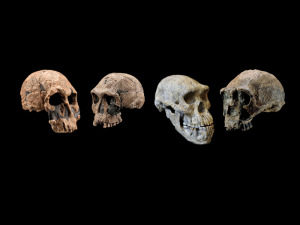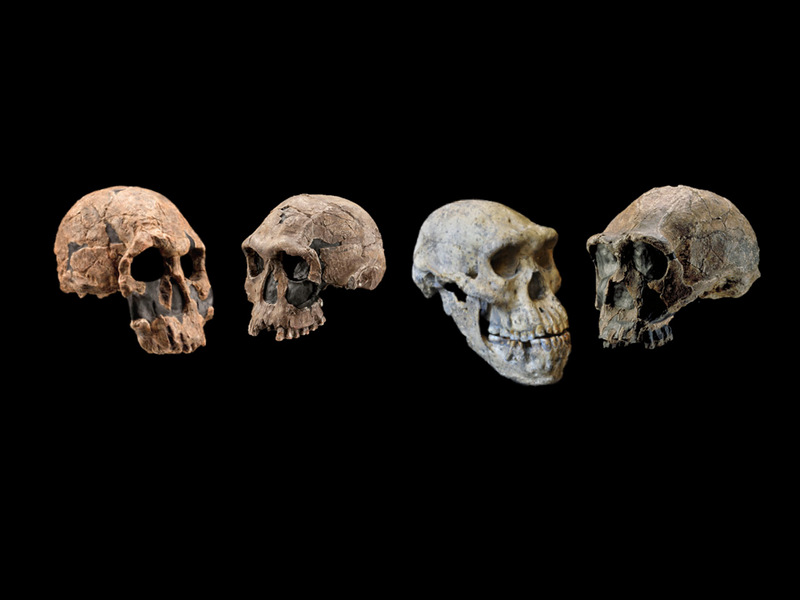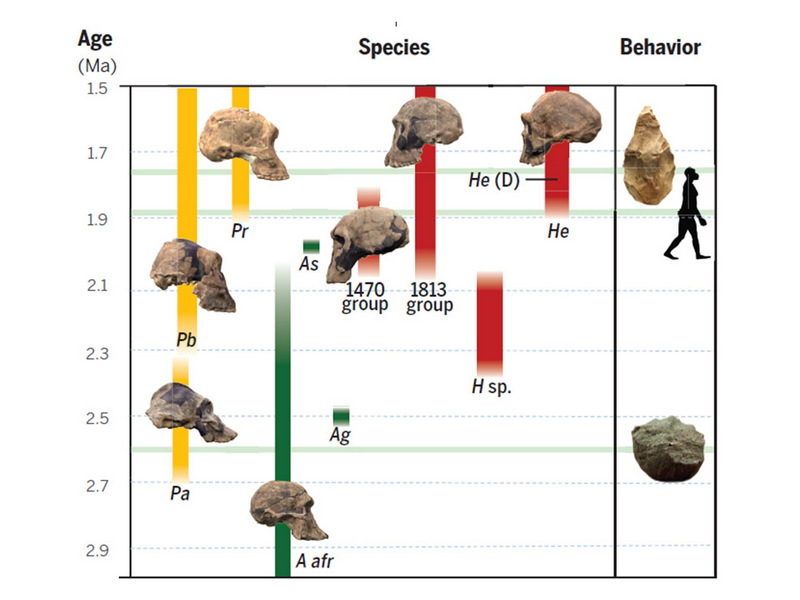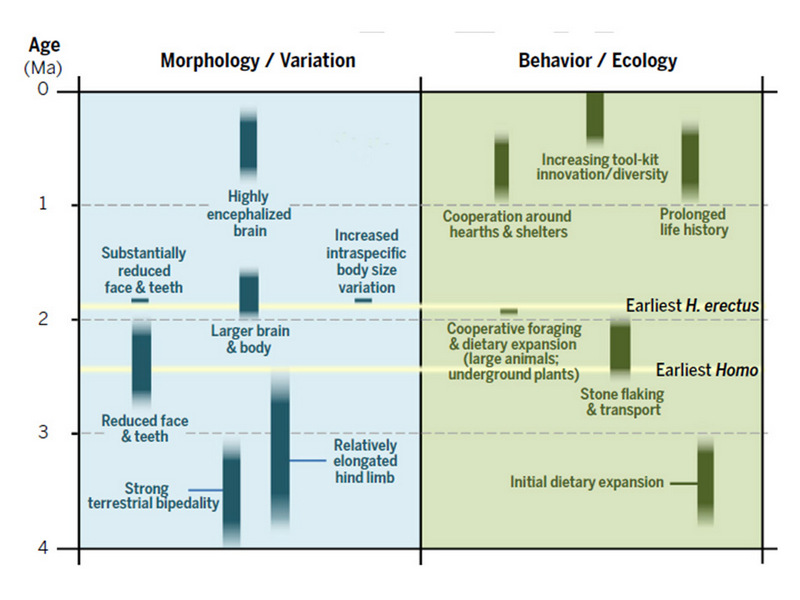
Gone are the days when paleoanthropologists could characterize the path of human evolution as a simple, single homogenous line of progressive changes in human morphology and behavior. Or so suggests a collaborative group of scientists who, as detailed in a study published in the July 4, 2014 issue of Science, came up with a new synthesis, or at least the rudimentary framework of one. It is a developing scenario that, they argue, more accurately explains how earlier forms of Homo (early humans) and their Australopithecus forerunners eventually led to the emergence of Homo sapiens (modern humans), the last surviving hominin.
Led jointly by Susan Antón, professor of anthropology at New York University, paleoanthropologist Richard Potts, curator of anthropology and director of the Human Origins Program at the Smithsonian’s National Museum of Natural History, and Leslie Aiello, president of the Wenner-Gren Foundation for Anthropological Research, the team studied paleoclimate, fossil, and stone tool evidence, leading to a developing consensus that suggests a rethinking of long-held assumptions about human origins and evolution. Based on a synthesis of the data, the researchers point to change and diversity of environmental conditions and the compelling need to survive by adapting to the changing conditions as a key to understanding how early humans were able to vary, survive and begin spreading from Africa to Eurasia 1.85 million years ago. The process entailed a diversification of species and genera differentiating and overlapping in time and morphology, beginning with some key elements once thought to define Homo but actually evolving in earlier Australopithecus ancestors between 3 and 4 million years ago.
Significant to the development of the new synthesis, Potts developed a new climate framework for East African human evolution that depicts most of the era from 2.5 million to 1.5 million years ago as a time of strong climate instability and shifting intensity of annual wet and dry seasons.
“Unstable climate conditions favored the evolution of the roots of human flexibility in our ancestors,” said Potts. “The narrative of human evolution that arises from our analyses stresses the importance of adaptability to changing environments, rather than adaptation to any one environment, in the early success of the genus Homo.”
_________________________________
 Between 2.1 and 1.8 million years ago, the oldest known species of the human genus, Homo, exhibited diverse traits. These species include the 1470 Group and the 1813 Group, based on the Kenyan fossils KNM-ER 1470 (left) and KNM-ER 1813 (second from left), respectively. By 1.8 to 1.9 million years ago, the species Homo erectus had evolved in Africa and started to spread to Eurasia. Early populations of this long-lived species are represented by the Kenyan fossil KNM- ER 3733 (right) and the Georgian fossil Dmanisi Skull 5 (second from right). The three lineages — the 1470 group, the 1813 group, and Homo erectus — overlapped in time for several hundred thousand years. The Kenyan fossils, from the site of Koobi Fora in the Lake Turkana region of Kenya, are housed in the National Museums of Kenya. Fossils from Dmanisi are housed in the Georgian National Museum. Credits: Kenyan fossil casts – Chip Clark, Smithsonian Human Origins Program; Dmanisi Skull 5 – Guram Bumbiashvili, Georgian National Museum
Between 2.1 and 1.8 million years ago, the oldest known species of the human genus, Homo, exhibited diverse traits. These species include the 1470 Group and the 1813 Group, based on the Kenyan fossils KNM-ER 1470 (left) and KNM-ER 1813 (second from left), respectively. By 1.8 to 1.9 million years ago, the species Homo erectus had evolved in Africa and started to spread to Eurasia. Early populations of this long-lived species are represented by the Kenyan fossil KNM- ER 3733 (right) and the Georgian fossil Dmanisi Skull 5 (second from right). The three lineages — the 1470 group, the 1813 group, and Homo erectus — overlapped in time for several hundred thousand years. The Kenyan fossils, from the site of Koobi Fora in the Lake Turkana region of Kenya, are housed in the National Museums of Kenya. Fossils from Dmanisi are housed in the Georgian National Museum. Credits: Kenyan fossil casts – Chip Clark, Smithsonian Human Origins Program; Dmanisi Skull 5 – Guram Bumbiashvili, Georgian National Museum
_______________________________
 Hominin evolution from 3.0 to 1.5 Ma. Green: Australopithecus, Yellow: Paranthropus, Red: Homo. The icons indicate from the bottom the first appearance of stone tools at ~2.6 Ma, the dispersal of Homo to Eurasia at ~1.85 Ma, and the appearance of the Acheulean technology at ~1.76 Ma. The number of contemporaneous hominin taxa during this period reflects different strategies of adaptation to habitat variability. The cultural milestones do not correlate with the known first appearances of any of the currently recognized Homo taxa. Image courtesy of Antón et al., Science/AAAS 2014
Hominin evolution from 3.0 to 1.5 Ma. Green: Australopithecus, Yellow: Paranthropus, Red: Homo. The icons indicate from the bottom the first appearance of stone tools at ~2.6 Ma, the dispersal of Homo to Eurasia at ~1.85 Ma, and the appearance of the Acheulean technology at ~1.76 Ma. The number of contemporaneous hominin taxa during this period reflects different strategies of adaptation to habitat variability. The cultural milestones do not correlate with the known first appearances of any of the currently recognized Homo taxa. Image courtesy of Antón et al., Science/AAAS 2014
______________________________
______________________________
Their analysis and conclusions could explain, at least in part, much of the new evidence that has emerged in recent years suggesting that multiple coexisting species of Homo overlapped geographically and developed differentiating morphological and behavioral characeristics. It contrasts with the long-held model of a large brain, long legs, the ability to craft tools and prolonged maturation periods evolving together as a single package at the start of the Homo lineage as African grasslands expanded and Earth’s climate became cooler and drier.
The researchers also analyzed ancient stone tools, isotopes found in teeth and cut marks found on animal bones in East Africa.
“Taken together, these data suggest that species of early Homo were more flexible in their dietary choices than other species,” said Aiello. “Their flexible diet—probably containing meat—was aided by stone tool-assisted foraging that allowed our ancestors to exploit a range of resources.”
The study authors concluded that flexibility likely strengthened the ability of human ancestors to successfully adapt to changing environments and emerge out of Africa, and explains the ability of the modern human species to occupy diverse habitats throughout the world.
The detailed study is published in the July 4, 2014 issue of Science magazine.
____________________________________________
Source: Adapted and edited from a press release of the Smithsonian Institution, Smithsonian scientist and collaborators revise timeline of human origins, 3 July 2014; and Early Human Traits Not Delivered in Single Package, Science, 3 July 2014.
____________________________________________
Read about the most fascinating discoveries with a premium subscription to Popular Archaeology Magazine. Find out what Popular Archaeology Magazine is all about. AND MORE:
On the go? Purchase the mobile version of a recent issue of Popular Archaeology Magazine here for only $2.99.
Popular Archaeology’s annual Discovery Edition eBook is a selection of the best stories published in Popular Archaeology Magazine in past issues, with an emphasis on some of the most significant, groundbreaking, or fascinating discoveries in the fields of archaeology and paleoanthropology and related fields. At least some of the articles have been updated or revised specifically for the Discovery edition. We can confidently say that there is no other single issue of an archaeology-related magazine, paper print or online, that contains as much major feature article content as this one. The latest issue, volume 2, has just been released. Go to the Discovery edition page for more information.





